
StudentManual главный источник
.pdf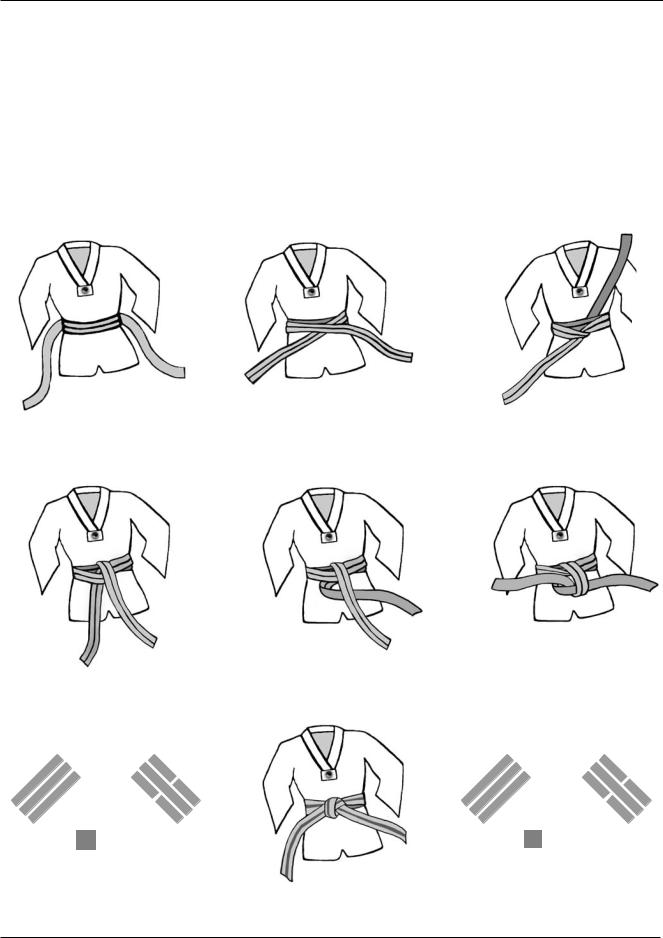
Master Chong’s World Class Tae Kwon Do
Instruction on Tying the Belt
“Dee”
Your “dee”, or belt, is a symbol of your learned knowledge of Tae Kwon Do. Always keep your belt tied properly, never draped around your neck. Never let your belt touch the ground, and do not wash it.
1. Locate the center of the belt and place it on the middle of your stomach.
2.Wrap the belt around your waist, bringing both ends to the front.
5.Make sure it is neat and snug, and then lay the top end down.
3.Make sure the ends are even. Put the right end over the left end.
6.Curve the bottom end to make a loop.
4.Now take that end and pull it up under both of the other layers.
7.Now pull the top end back up through the loop.
 [
[ 8. Pulltighteningboth endsyourhorizontally,knot.
8. Pulltighteningboth endsyourhorizontally,knot.  [
[
20
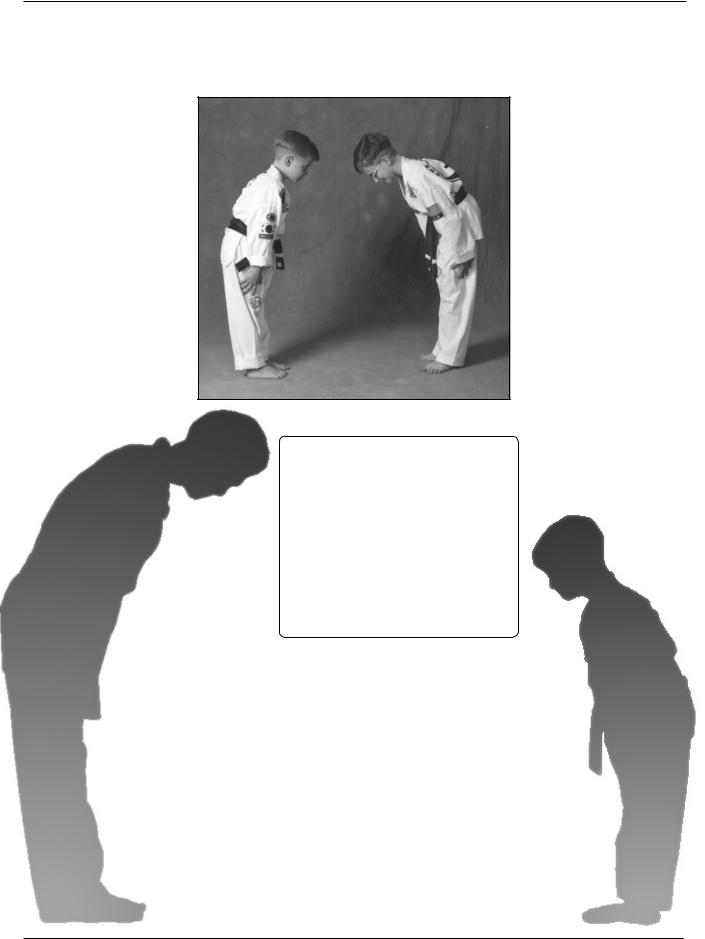
Introduction
Bowing and Its Purpose
Bowing is a form of body language in Asian countries. A bow can be used to say “hello”, “good bye”,“thankyou”, and “you’re welcome”.
Bowing is also a way of showing courtesy and acceptance. When two people bow to each other they are showing mutual respect.
T r a d i t i o n a l l y , Tae Kwon Do students demonstrate respect by bowingtotheflagsbefore entering or leaving the
training floor, to the instructor, to senior belts at the beginning and the end of class, and to a partner before and after each interaction. It is a part of Tae Kwon Do to bow whenever and wherever you see each other.
Over time, you will find that bowing has become a natural form of expressing the special relationship you have with your fellow Tae Kwon Doists.
Bowing is a two-way street, a shared expression.
Students learn that to earn respect and to give respect
are very much the same thing.
An Old Saying:
“When in doubt, bow!”
HOW TO BOW
1.The student stands at attention, head up, shoulders down, back straight, relaxed.
2.Either both feet are together, or the heels are touching and the toes are pointing outward at a 45 degree angle, in a V-shape.
3.The hands should be held straight at the sides of the body.
4.Bend the head down to a 45 degree angle and bend deeply at the waist.
5.When bowing, one’s eyes look downward.
21

Master Chong’s World Class Tae Kwon Do
Kihap: The Energy Yell
The kihap (pronounced “key hap”) is a very important part of Tae Kwon Do training. When properly practiced, this special kind of yell combines sound with breathing in one explosive burst. The kihap should not come from the throat, but from deep down in the stomach, using the diaphragm to forcefully push air up and out through the mouth. The kihap is one of the most distinctive elements of Tae Kwon Do practice; no two students’ kihaps are identical. You will find that as your Tae Kwon Do skills change and grow, so will your kihap.
The Kihap
Serves Several Purposes:
• It ensures that students breathe while exerting themselves, for greater endurance and energy.
• It heightens mental focus and concentration by making students more aware of each technique.
• It helps to reduce tension.
• During drills with a partner, the kihapisoftenusedtocommunicate that you are ready.
• It is an expression of confidence.
• Itisawaytomotivateyourselfand others by sharing your intensity and spirit.
• In self defense, a loud and powerful kihap can startle an attacker giving you additional time to react or get away.
22
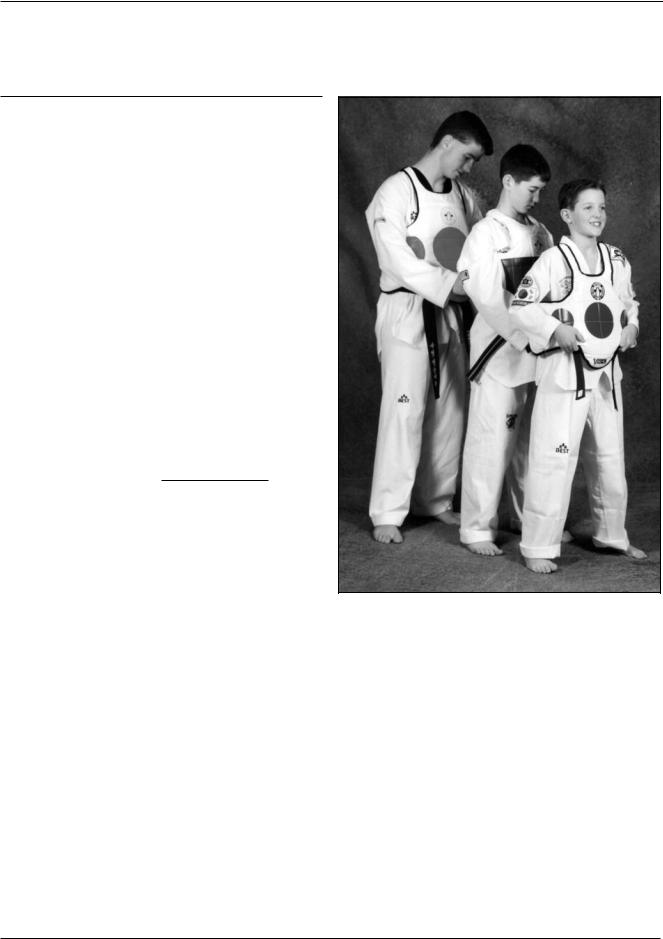
Introduction
Rules for Sparring
At Master Chong’s World Class Tae Kwon Do, our primary concern is providing safe, beneficial classes for our students. As a result, the following safety measures are required for all students.
nNo sparring is permitted prior to the yellow belt level.
nAt yellow belt, students are required to purchase a safety equipment package consisting of a headgear, mouth piece, gloves, shin and instep pads, and a groin cup for males.
nStudents must wear all of the above equipment for all in class sparring.
nThe rules for sparring in standard color belt classes are as follows:
-Students may perform kicks toward their opponents body or face.
-Students may perform punches only toward their partner’s body.
-No contact is to be made at any time.
nThe rules for sparring classes are as follows:
-In order to participate in sparring class students are required to purchase a chest protector and forearm guards in addition to the items included with the mandatory yellow belt safety gear package.
-Students are permitted to make light contact with kicks or punches to the chest protector of their partner.
-Students may attempt kicks towards their partner’s headgear, however no contact is allowed. -No hand techniques may be attempted to the head or facial area in sparring.
-All students are responsible for notifying their training partner and/or an instructor if they feel their partner is going beyond the acceptable levels of contact.
The rules and regulations for tournament competition are different from those listed above. Students interested in competing in outside tournaments should consult their instructors.
n All sparring requires instructor supervision.
23

Master Chong’s World Class Tae Kwon Do
Answers to Common Questions
About Advancement and Belt Promotion
How many belts are there, and what purpose do they serve?
Advancement in Tae Kwon Do is symbolized by a series of 11 increasingly darker colored belts. At Master Chong’s World Class Tae Kwon Do, those belts are: white, yellow, yellow with a green stripe, green, green with a blue stripe, blue, blue with a red stripe, red, red with a single black stripe, red with double black stripes, and black. Different martial arts schools, and even some other Tae Kwon Do schools, use different colors. The purpose, however, is the same: to provide students with a system for measuring progress through short term goals on route to the long term goal of black belt.
Howdoesoneadvancethrough the different color belts?
Students must memorize, practice and satisfactorily perform a number of requirements, including: kicks, blocks, punches, choreographed routines (forms), block and counter drills (one step sparring), escapes from different grabs and holds (self defense),
“live” drills with a partner (free sparring) and board breaking with both kicks and hand strikes.
There are also Korean terms, written tests on Tae Kwon Do history and practice, as well as essays. A specific listing of the requirements that must be performed for each rank promotion is outlined on the black
belt curriculum posted in the school’s lobby. It is also outlined in detail in each of the specific belt sections of this manual.
How do the instructors cover all the material necessary to prepare students for testing?
Throughout the month, the instructors teach a variety of different classes designed to challenge, motivate and develop each student. Individual classes may focus more on certain areas and less on others. If students consistently attend two classes per week, they will be exposed to all of the material required for advancement.
Do children and adults learn the same requirements for color belt and black belt testing?
Yes. The same curriculum is required for each student at each belt level. Children and adults have different strengths and weaknesses with regard to the requirements. Some children’s bodies are able to adapt quite readily to the new physical techniques, while many adults are able to understand the theory of the movements more rapidly. In both cases, advancement is based on knowledge of curriculum and
“personal best” performance.
Advancement is based on knowledge of curriculum and “personal best” performance.
24
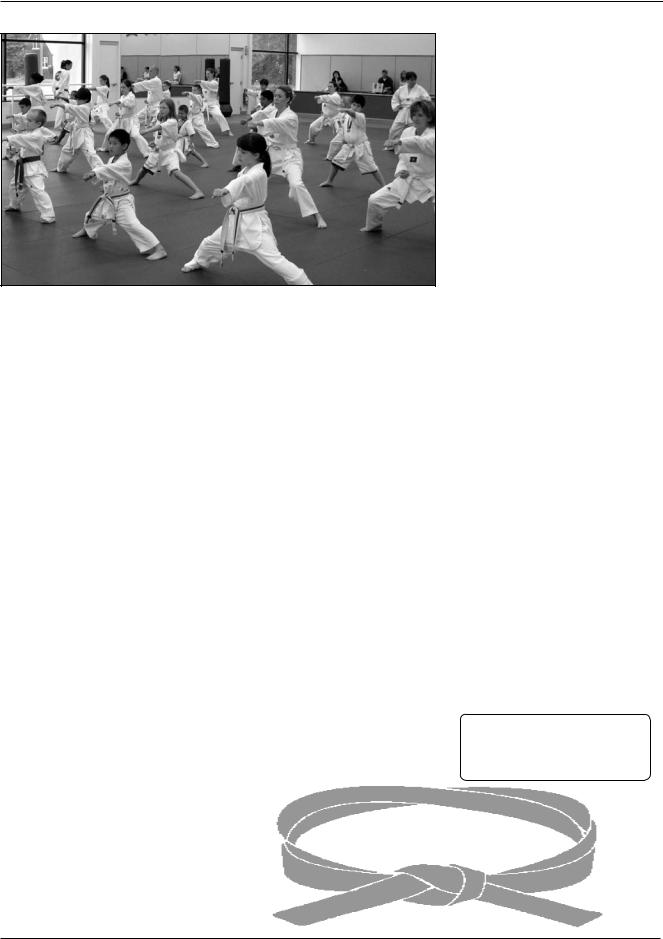
Introduction
When are belt tests held and who conducts them?
Belt testing is generally held one day during the month. On that day, no regular classes are held. Students who are eligible to test are scheduled to come at a reserved time. All test candidates are graded by our school’s founder Grandmaster Sun Chong. The school master, and often times the senior instructor, also sit on the testing board. This allows them to answer any questions Grandmaster Chong may have on the student’s day to day training and to inform him of any special areas of interest about an individual student. They are also able to receive feedback from Grandmaster Chong on each student’s progress.
What are the procedures for Black Belt Testing and promotion?
Black Belt testing is conducted three times a year during the months of April, August and December. At those times, Grandmaster Chong continues to serve on the testing board and is often assisted by guest masters from other schools.
Black Belt promotion is done three times per year in conjunction with the scheduled Black Belt tests. Students who have tested for their Black Belt experience a four month “probation period”.
During this time they are allowed to start wearing a black collar uniform and receive a half red/ half black belt. They are also allowed to start attending Black Belt classes and training with current Black Belts.
More information about Black Belt testing procedures and preparation is available in a separate folder given to students prior to testing.
I have noticed that students also have strips of tape on their belts, and I have heard about “tip testing”. What is this exactly?
Although they are not actual belt ranks, tips are used to:
•Recognize student progress on their requirements.
•Provide students with smaller goals for additional motivation.
•Assist the instructors, by indicating the amount of curriculum each student has learned toward their next belt level.
For the color belts, how many tips are there and what do they represent? When does a student test for them?
Our tip system is as follows:
•Whitebeltusesthreeyellowtips and one black tip.
•Yellow belt and green stripe use one white tip, one green tip, and one black tip.
•Green belt through single black stripe use one white tip, two yellow tips, and one black tip.
•Double black stripe uses two white tips and two yellow tips.
The tips represent the instructors’ “stamp of approval”...
25
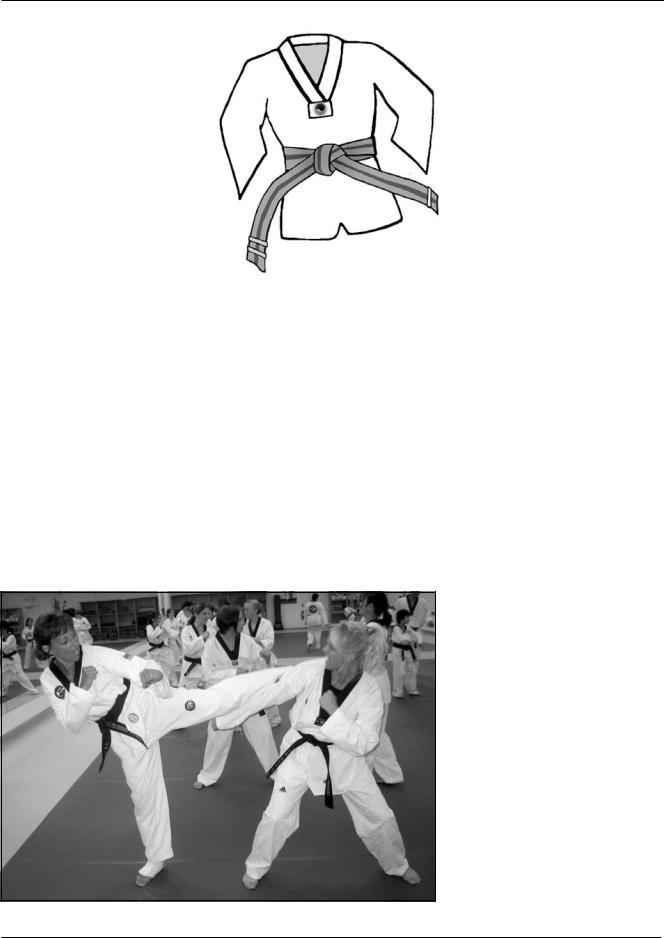
Master Chong’s World Class Tae Kwon Do
The tips represent the instructors’ “stamp of approval” regarding a student’s performance of a particular belt requirement. Tips are therefore stepping stones towards preparing for a belt test. To earn a tip, a student must not only memorize a belt requirement, but perform it technically correct and at a level the instructors deem to be the student’s “personal best”.
There is no formal exam or scheduled testing day for students to obtain tips. Rather, the instructors teach and evaluate students on an ongoing basis and present tips in classes as they deem the students ready.
It is important to remember that performance, rather than memorization, is the key to obtaining tips. For each belt level, a student who has obtained all required tips will be eligible for the next belt test, as long as they also meet the time and class attendance requirements.
What is the purpose of the time and attendance requirements?
The time requirement was established for the benefit of all students. Most students, both children and adults, will need at least the minimum amount of time in order to be properly prepared for the belt exam. Some students who are naturally fast learners or gifted athletes may feel they can progress at a quicker pace. However, the personal best standards, set by the instructors,
will challenge those students to raise their performance to an even higher level prior to testing, and they will therefore benefit from the additional practice time.
What does the phrase “personal best” mean?
At Master Chong’s World Class Tae Kwon Do, we recognize that our students vary tremendously in age, learning rate, and natural physical capability. As a result, it would be unrealistic to hold everyone to the exact same standard of performance level.
Although every student must memorize the same requirements for each belt, the instructors use their experience and daily interaction with students to determinea“personalbest”level.
This level is both challenging and attainable. Therefore, the performance standard for each student is based on the instructors’ interpretation of an individual student’s “personal best.”
What about comparing one student to another?
No two students are exactly the same, so a fair comparison cannot be made. Two students at the same level must memorize the same requirements, however, their age, athleticabilityandlearningratewill determine individual performance requirements. Our philosophy is that each student is working toward their individual “personal best.” By encouraging students to compete with themselves, we are able to continuously place a
26
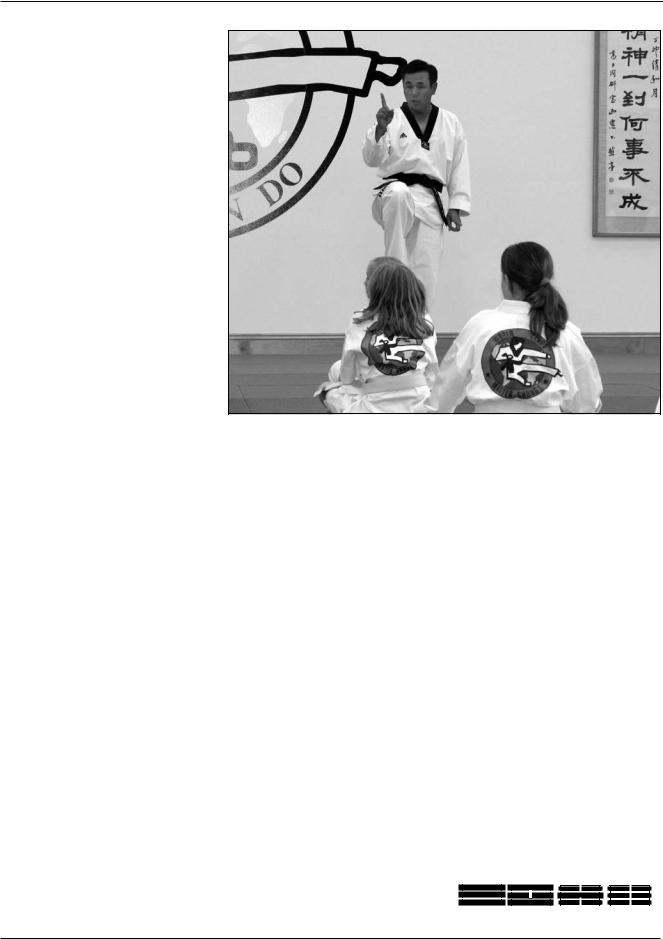
Introduction
goal in front of them that is both challenging and attainable.
Who decides when a student is ready for a tip or belt test, and how should I communicate with instructors regarding questions about progress?
Students and parents are asked to remember that testing represents a progress check, and the instructors’experience and day to day interaction with the students make them uniquely qualified to determine a student’s readiness for testing. At the same time, we believe that communication between the students, parents and instructors is a vital part of the learning process, and we welcome your questions and concerns. If you are uncertain about the status of your child’s or your own progress, you may mention this to the instructors. You can trust that they will take care of the situation professionally.
All of our instructors are committed to making recommendations for testing based solely on what is in the student’s best interest. If they are encouraging a student to wait, it is only because they believe the student has the capability to learn more and perform at a higher level prior to testing. If they are encouraging a student to proceed, it is because they feel the student has reached their personal best level and needs to move on to new material in order to stay challenged and motivated.
If a parent or student has additional questions or concerns
about an instructor’s decision, they may set up a private conference to express those concerns and to discuss the instructor’s recommendation. Together we will work to find the best path for the student to achieve success!
What do the instructors do when a student has difficulty with a particular requirement during their test?
The instructors give a student permission to test only after they are satisfied that the student has the knowledge and ability necessary to be successful on testing day. However, not all students perform at their best on the day of testing, sometimes due to nervousness, and mistakes are not uncommon. If a student struggles with a requirement to the degree that they forget it or
are unable to complete it during testing, they will be required to
“make up” that segment at a later date, prior to promotion.
Our testing is not done on a pass/fail basis, but rather it is similar to academic schools’ use of letter grading. Therefore, it is possible for a student to have a lower score in some areas and higher score in others, and still pass to the next belt.
In addition, the instructors use testing not just to determine who receives a new belt, but as a way to assess the progress of each student. This assessment is then used to adjust future classes and lesson plans, as well as areas of emphasis to match the needs of the students.
27

Master Chong’s World Class Tae Kwon Do
|
|
|
|
|
|
|
|
What about the “Student of |
||||||
|
|
|
|
|
|
|
|
|||||||
|
|
|
|
|
|
|
|
the Month” award”? |
|
|||||
|
|
|
|
|
|
|
|
The “Student of the Month” |
||||||
|
|
|
|
|
|
|
|
award is not directly related |
||||||
|
|
|
|
|
|
|
|
with either belt promotion or |
||||||
|
|
|
|
|
|
|
|
trophies. It is a different form of |
||||||
|
|
|
|
|
|
|
|
recognition designed to motivate |
||||||
|
|
|
|
|
|
|
|
both children and adult students |
||||||
|
|
|
|
|
|
|
|
to become better Tae Kwon |
||||||
|
|
|
|
|
|
|
|
Doists. An award is presented |
||||||
|
|
|
|
|
|
|
|
to one outstanding child and one |
||||||
|
|
|
|
|
|
|
|
outstanding adult at the beginning |
||||||
|
|
|
|
|
|
|
|
of each month for their attitude |
||||||
|
|
|
|
|
|
|
|
and performance exhibited during |
||||||
|
|
|
|
|
|
|
|
the previous month. |
|
|||||
|
|
|
|
|
|
|
|
Selection of the “Student |
||||||
If a student passes a color |
Kihap (energy yell), and “Most |
of the Month” is based on |
||||||||||||
belt test, when do they receive |
Improved.” Thereisalsoatrophy |
M a s t e r C h o n g ’s |
Wo r l d |
|||||||||||
their belt? |
for “Best All Around,” which |
Class Tae Kwon Do lifeskill |
||||||||||||
Promotions to a new color belt |
encompasses all the categories. |
curriculum. The criteria includes |
||||||||||||
The “Most Improved” trophy |
the student’s demonstration of |
|||||||||||||
are given out after warm-up |
is awarded to a student who the |
focus, enthusiasm, goal setting, |
||||||||||||
exercises, beginning the day |
instructors deem to have made |
cooperation, self |
control, |
|||||||||||
following testing. Students are |
substantial progress since their |
perseverance,confidence,respect, |
||||||||||||
always promoted in front of their |
previous test. |
responsibility, and leadership. |
||||||||||||
current classmates. As a result, |
Trophies are awarded to those |
|
|
|
|
|
|
|
||||||
students should continue to attend |
|
|
|
|
|
|
|
|||||||
who receive a score of an “A” or |
|
|
The “Student of |
|||||||||||
the classes held for their current |
|
|
||||||||||||
belt level up to and including the |
better and whose personal best |
|
|
the Month” award |
||||||||||
day of their promotion. Once they |
performance is inspiring to others. |
|
|
is presented to one |
||||||||||
have received their promotion |
Because this is an extremely high |
|
outstanding child and |
|||||||||||
they should begin attending the |
standard, not every trophy is |
|
one outstanding adult |
|||||||||||
appropriate class for their new |
awarded at each test. The purpose |
|
|
at the beginning of |
||||||||||
level. |
of awarding trophies is to serve |
|
|
|
each month |
|
||||||||
as an additional incentive for |
|
|
for their attitude and |
|||||||||||
|
|
|
||||||||||||
What trophies are awarded at |
students to give their best effort |
performance exhibited |
||||||||||||
testing and how are the winners |
on testing day and to recognize |
|
|
during the previous |
||||||||||
chosen? |
excellent performances. |
|
|
|
|
month. |
|
|||||||
[ |
|
|
|
|||||||||||
Trophies are available for |
|
|
|
|||||||||||
outstanding performances by |
|
|
|
|||||||||||
both adults and children in the |
|
|
|
|||||||||||
|
|
|
|
|
|
|
|
|
|
|
|
|
|
|
following categories: |
|
|
|
|
|
|
|
|
|
|
|
|
|
|
|
|
|
|
|
|
|
|
|
|
|
|
|
|
|
|
|
|
|
|
|
|
|
|
|
|
|
|
|
|
Poomse (form), Ilsushik (one |
|
|
|
|
|
|
|
|
|
|
|
|
|
|
|
|
|
|
|
|
|
|
|
|
|
|
|
|
|
|
|
|
|
|
|
|
|
|
|
|
|
|
|
|
step sparring), Ho Shin Sool |
|
|
|
|
|
|
|
|
|
|
|
|
|
|
|
|
|
|
|
|
|
|
|
|
|
|
|
|
|
(self defense), Kyukpa (board |
|
|
|
|
|
|
|
|
|
|
|
|
|
|
breaking), Gyoroogi (sparring), |
|
|
|
|
|
|
|
|
|
|
|
|
|
|
|
|
|
|
|
|
|
|
|
|
|
|
|
|
|
28 |
|
|
|
|
|
|
|
|
|
|
|
|
|
|

Master Chong’s World Class Tae Kwon Do
Black Belt Curriculum
Yellow Belt |
Green Stripe |
Green Belt |
|
|
Stances: |
All Basic |
|
Stances: |
Stances, |
||
basics, back |
Blocks, and |
||
ready, attention |
Blocks: |
Punches |
|
horse riding, |
|
||
forward, kicking |
double knifehand, |
Kicks: |
|
|
inside body |
||
|
back |
||
Blocks: |
|
||
Strikes: |
|
||
face, body, down |
|
||
knifehand |
knifehand, |
Form: |
|
|
reverse knifehand |
Pal Gwe 2 |
|
Kicks: |
Kicks: |
|
|
front snap, |
One Step |
||
basics, side |
|||
front rising, |
|||
|
Sparring: |
||
crescent, side, |
Form: |
||
1-3 |
|||
roundhouse |
Pal Gwe 1 |
|
|
Form: |
One Step |
Free Sparring |
|
Kibon Poomse |
Sparring: |
|
|
|
1-3 |
Board |
|
One Step |
|
||
Free Sparring |
Breaking: |
||
Sparring: |
|||
side kick |
|||
|
|||
1-3 |
|
||
Board Breaking: |
|
||
|
|
||
Korean Terms |
side kick |
Korean Terms |
|
|
|||
#1 |
Korean Terms |
#3 |
|
Black Belt |
#2 |
|
|
|
Black Belt |
||
Philosophy: |
Black Belt |
||
Philosophy: |
|||
Focus |
Philosophy: |
||
Goal Setting |
|||
|
Enthusiasm |
||
|
|
Blue Stripe
Form:
Pal Gwe 3
One Step Sparring:
1-3
Self Defense: single wrist grabs 1-3
Free Sparring
Board Breaking: back kick
Korean Terms #4
Black Belt
Philosophy:
Cooperation
Blue Belt
Basic Falls
Combination
Block and
Strike
Techniques
Form:
Pal Gwe 4
One Step Sparring:
1-3
Self Defense: double wrist grabs 1-3
Free Sparring
Board Breaking: back kick
Korean Terms #5
Black Belt
Philosophy:
Self Control
Red Stripe |
Kicks:
jump front snap kick, jump roundhouse kick, flying side kick
Form:
Pal Gwe 5
One Step Sparring:
1-3
Self Defense: front shoulder grabs 1-3
Free Sparring
Board Breaking: spinning kick
Written Exam #1
Black Belt
Philosophy:
Perseverance
Red Belt
Advanced
Takedowns
and Joint
Locks
Form:
Pal Gwe 6
One Step Sparring:
1-3
Self Defense: back shoulder grab 1-3
Free Sparring
Board Breaking: spinning kick
Written Exam #2
Black Belt
Philosophy:
Confidence
Black Stripe 


Combination
Breaking
Techniques
Kicks: jump back, spinning
Form:
Pal Gwe 7
One Step Sparring:
1-3
Self Defense: various front grabs 1-3
Free Sparring
Board Breaking:
1 hand technique and spinning kick
Essay:
Respect
Black Belt
Philosophy:
Respect
Double Black |
Black Belt |
Stripe |
|
Kicks: |
All |
|
requirements |
||
double kicks, |
from all |
|
jump 360o back |
previous belts |
|
kick and jump |
|
|
turning axe kick |
Forms: |
|
|
||
Form: |
All, at random |
|
|
||
Pal Gwe 8 |
One Step |
|
|
||
One Step |
Sparring: |
|
Choreographed |
||
Sparring: |
|
|
1-3 |
Self Defense: |
|
|
Choreographed |
|
Self Defense: |
3 Station |
|
bear hug 1-2, |
||
rear double wrist |
Board |
|
grab |
Breaking |
|
Free Sparring |
Essay: |
|
Leadership: |
||
|
||
Board |
Tae Kwon Do |
|
and My Life |
||
Breaking: |
|
|
1 hand technique |
4 Hour |
|
and spinning kick |
Preparation |
|
Essay: |
Class |
|
|
||
Responsibility |
4 Hour |
|
|
Candidate |
|
Black Belt |
Class |
|
Philosophy: |
Black Belt |
|
Responsibility |
||
|
Philosophy: |
|
|
Leadership |
 29
29
Introduction
